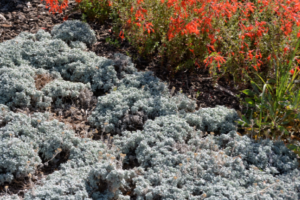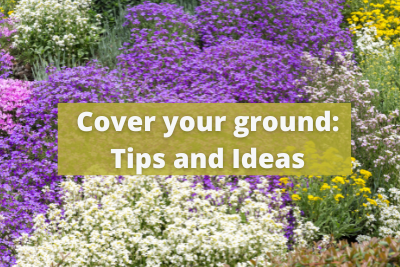You’ve tried and tried, but the grass simply won’t grow. Many of us have had to figure out what to do with bare spots on our property. Or this problem: we don’t want the grass to grow. On steep slopes. Around trees, water holes, and other natural impediments. Places we wouldn’t dare take our lawn mower.
One obvious solution to these problems is to plant ground cover. But what if we reimagined ground cover and saw it as a cool landscape design that we chose for aesthetics vs. a necessity for a problem area?
 The possibilities are endless. And the concept is big right now. Not only are there design ideas for every budget, in many cases ground cover can save you money in grass seed, fertilizer and weed control products, not to mention your water bill.
The possibilities are endless. And the concept is big right now. Not only are there design ideas for every budget, in many cases ground cover can save you money in grass seed, fertilizer and weed control products, not to mention your water bill.
Sure, drought-tolerant hardy ice plant or popular Pachysandra go great no matter why you choose them, but there are independent landscapers out there who can plant not-so-obvious species, tuck them into your landscape in unique ways to show flair and creativity, and at the same time cut down on lawn care chores.
Want less lawn without losing curb appeal? How about the perennial white-leaf snow-in-summer flower? English ivy not your thing? Why not creeping phlox? Put that violet color against the green of a lush lawn and the dark brown of mulch around the base of a white birch tree and you have a picturesque landscape exploding in color.
There are a number of native ground covers that would nestle nicely into oddly-shaped areas, among rocky outcrops, or along a gentle curve to accent a neatly trimmed lawn edge.
Common wild ginger, Eastern hay-scented fern, and wild Strawberry are excellent native ground cover options for shady or partly shaded areas. And they are good for the environment.
 Well-chosen ground covers can create spectacular island beds. Throw in some accents like narrow stone walkways and it can look like nature intended it to look that way.
Well-chosen ground covers can create spectacular island beds. Throw in some accents like narrow stone walkways and it can look like nature intended it to look that way.
Want a formal garden? There is an endless list of flower and shrub choices and it’s a perfect opportunity to create symmetry with a repeating design of potted plants, anchored by a central planter — one feature of a formal garden.
Turn a steep slope into a lush garden feel with a single species or drifts of different plants.
You can get any number of ideas simply by walking around your neighborhood or dropping in at a lawn care dealer to ask about options.
We know of one landscaper who will try out a plant in one area and, if it doesn’t work, will try it someplace else. As you look at a plot of land on your property, the idea is to ask yourself: what other kinds of horticulture might go here?

